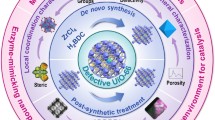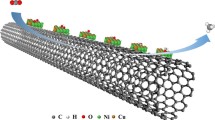Abstract
Ionic liquids (ILs) have the advantages of low cost, eco-friendliness, abundant heteroatoms, excellent solubility, and coordinated ability with metal ions. These features make ILs a suitable precursor for fabricating metal single-atom catalysts (SACs). Herein, we prepared various metal single atoms anchored on ultrathin N-doped nanosheets (denoted as Cu1/NC, Fe1/NC, Co1/NC, Ni1/NC, and Pd1/NC) by direct pyrolysis using ILs and g-C3N4 nanosheets as templates. Taking benzene oxidation to phenol with H2O2 as a model reaction to evaluate their catalytic performance and potential applications, Cu1/NC calcined at 1000°C (denoted as Cu1/NC-1000) exhibits the highest activity with a turnover frequency of about 200 h−1 in the first 1 h at 60°C, which is better than that of most metal SACs reported in the literature. High benzene conversion of 82% with high phenol selectivity of 96% and excellent recyclability were achieved using the Cu1/NC-1000 catalyst. This study provides an efficient general strategy for fabricating SACs using ILs for catalytic applications.

摘要
离子液体具有成本低、环境友好、杂原子丰富、溶解性好、与金属离子良好的配位能力等优点, 是一种理想的用于制备金属单原子催化剂的前驱体材料. 在本文中, 我们利用离子液体与金属的强配位能力, 以g-C3N4纳米片为结构模板, 合成了多种锚定在氮掺杂超薄碳纳米片上的金属单原子催化剂(分别简写为Cu1/NC、Fe1/NC、Co1/NC、Ni1/NC和Pd1/NC). 将上述金属单原子催化剂用于双氧水氧化苯制苯酚反应中, 1000°C煅烧得到的铜单原子催化剂(Cu1/NC-1000)表现出最高的活性, 60°C时反应1 h的转换频率(TOF)约为200 h−1, 优于文献报道的大多数金属单原子催化剂. 随着反应时间延长, 最终苯的转化率可达82%, 苯酚的选择性维持在96%. 此外, Cu1/NC-1000催化剂具有良好的循环稳定性. 本研究为制备单原子催化剂提供了一种新的有效的普适性策略.
Similar content being viewed by others
References
Fei H, Dong J, Chen D, et al. Single atom electrocatalysts supported on graphene or graphene-like carbons. Chem Soc Rev, 2019, 48: 5207–5241
Qiao B, Wang A, Yang X, et al. Single-atom catalysis of CO oxidation using Pt1/FeOx. Nat Chem, 2011, 3: 634–641
Kaiser SK, Chen Z, Faust Akl D, et al. Single-atom catalysts across the periodic table. Chem Rev, 2020, 120: 11703–11809
Li Z, Ji S, Liu Y, et al. Well-defined materials for heterogeneous catalysis: From nanoparticles to isolated single-atom sites. Chem Rev, 2020, 120: 623–682
Gawande MB, Fornasiero P, Zbořil R. Carbon-based single-atom catalysts for advanced applications. ACS Catal, 2020, 10: 2231–2259
Zhang L, Zhou M, Wang A, et al. Selective hydrogenation over supported metal catalysts: From nanoparticles to single atoms. Chem Rev, 2020, 120: 683–733
Ji S, Chen Y, Wang X, et al. Chemical synthesis of single atomic site catalysts. Chem Rev, 2020, 120: 11900–11955
Rong H, Ji S, Zhang J, et al. Synthetic strategies of supported atomic clusters for heterogeneous catalysis. Nat Commun, 2020, 11: 5884
Wan C, Duan X, Huang Y. Molecular design of single-atom catalysts for oxygen reduction reaction. Adv Energy Mater, 2020, 10: 1903815
Qin R, Liu K, Wu Q, et al. Surface coordination chemistry of atomically dispersed metal catalysts. Chem Rev, 2020, 120: 11810–11899
Peng L, Shang L, Zhang T, et al. Recent advances in the development of single-atom catalysts for oxygen electrocatalysis and zinc-air batteries. Adv Energy Mater, 2020, 10: 2003018
Li Q, Chen W, Xiao H, et al. Fe isolated single atoms on S, N codoped carbon by copolymer pyrolysis strategy for highly efficient oxygen reduction reaction. Adv Mater, 2018, 30: 1800588
Zhuo HY, Zhang X, Liang JX, et al. Theoretical understandings of graphene-based metal single-atom catalysts: Stability and catalytic performance. Chem Rev, 2020, 120: 12315–12341
Yang J, Li W, Wang D, et al. Electronic metal-support interaction of single-atom catalysts and applications in electrocatalysis. Adv Mater, 2020, 32: 2003300
Wang L, Chen MX, Yan QQ, et al. A sulfur-tethering synthesis strategy toward high-loading atomically dispersed noble metal catalysts. Sci Adv, 2019, 5: eaax6322
Zhao L, Zhang Y, Huang LB, et al. Cascade anchoring strategy for general mass production of high-loading single-atomic metal-nitrogen catalysts. Nat Commun, 2019, 10: 1278
Long X, Li Z, Gao G, et al. Graphitic phosphorus coordinated single Fe atoms for hydrogenative transformations. Nat Commun, 2020, 11: 4074
Shen Q, Cao C, Huang R, et al. Single chromium atoms supported on titanium dioxide nanoparticles for synergic catalytic methane conversion under mild conditions. Angew Chem Int Ed, 2020, 59: 1216–1219
Welton T. Room-temperature ionic liquids. Solvents for synthesis and catalysis. Chem Rev, 1999, 99: 2071–2084
Wasserscheid P, Keim W. Ionic liquids—new “solutions” for transition metal catalysis. Angew Chem Int Ed, 2000, 39: 3772–3789
Zhao D, Fei Z, Scopelliti R, et al. Synthesis and characterization of ionic liquids incorporating the nitrile functionality. Inorg Chem, 2004, 43: 2197–2205
Lin IJB, Vasam CS. Metal-containing ionic liquids and ionic liquid crystals based on imidazolium moiety. J Organomet Chem, 2005, 690: 3498–3512
Gong J, Antonietti M, Yuan J. Poly(ionic liquid)-derived carbon with site-specific N-doping and biphasic heterojunction for enhanced CO2 capture and sensing. Angew Chem Int Ed, 2017, 56: 7557–7563
Wang J, Duan X, Gao J, et al. Roles of structure defect, oxygen groups and heteroatom doping on carbon in nonradical oxidation of water contaminants. Water Res, 2020, 185: 116244
Cui X, Li W, Junge K, et al. Selective acceptorless dehydrogenation of primary amines to imines by core-shell cobalt nanoparticles. Angew Chem Int Ed, 2020, 59: 7501–7507
Ding S, Guo Y, Hülsey MJ, et al. Electrostatic stabilization of singleatom catalysts by ionic liquids. Chem, 2019, 5: 3207–3219
Ren W, Tan X, Chen X, et al. Confinement of ionic liquids at single-Ni-sites boost electroreduction of CO2 in aqueous electrolytes. ACS Catal, 2020, 10: 13171–13178
Xu T, Waehler T, Vecchietti J, et al. Gluing ionic liquids to oxide surfaces: Chemical anchoring of functionalized ionic liquids by vapor deposition onto cobalt(II) oxide. Angew Chem Int Ed, 2017, 56: 9072–9076
Bauman Jr. JE, Wang JC. Imidazole complexes of nickel(II), copper(II), zinc(II), and silver(I). Inorg Chem, 1963, 3: 368–373
Liu J, Yu Y, Qi R, et al. Enhanced electron separation on in-plane benzene-ring doped g-C3N4 nanosheets for visible light photocatalytic hydrogen evolution. Appl Catal B-Environ, 2019, 244: 459–464
Ravel B, Newville M. ATHENA, ARTEMIS, HEPHAESTUS: Data analysis for X-ray absorption spectroscopy using IFEFFIT. J Synchrotron Rad, 2005, 12: 537–541
Koningsberger DC, Prins R. X-Ray Absorption: Principles, Applications, Techniques of EXAFS, SEXAFS, and XANES. Vol. 92. New York: Wiley, 1988
Rehr JJ, Albers RC. Theoretical approaches to X-ray absorption fine structure. Rev Mod Phys, 2000, 72: 621–654
Li F, Han GF, Noh HJ, et al. Boosting oxygen reduction catalysis with abundant copper single atom active sites. Energy Environ Sci, 2018, 11: 2263–2269
Zhang T, Zhang D, Han X, et al. Preassembly strategy to fabricate porous hollow carbonitride spheres inlaid with single Cu-N3 sites for selective oxidation of benzene to phenol. J Am Chem Soc, 2018, 140: 16936–16940
Wang Y, Jia G, Cui X, et al. Coordination number regulation of molybdenum single-atom nanozyme peroxidase-like specificity. Chem, 2021, 7: 436–449
Pan Y, Chen Y, Wu K, et al. Regulating the coordination structure of single-atom Fe-NxCy catalytic sites for benzene oxidation. Nat Commun, 2019, 10: 4290
Li H, Cao C, Liu J, et al. Cobalt single atoms anchored on N-doped ultrathin carbon nanosheets for selective transfer hydrogenation of nitroarenes. Sci China Mater, 2019, 62: 1306–1314
Huang R, Cao C, Liu J, et al. Integration of metal single atoms on hierarchical porous nitrogen-doped carbon for highly efficient hydrogenation of large-sized molecules in the pharmaceutical industry. ACS Appl Mater Interfaces, 2020, 12: 17651–17658
Yang JH, Sun G, Gao Y, et al. Direct catalytic oxidation of benzene to phenol over metal-free graphene-based catalyst. Energy Environ Sci, 2013, 6: 793–798
Zhu Y, Sun W, Luo J, et al. A cocoon silk chemistry strategy to ultrathin N-doped carbon nanosheet with metal single-site catalysts. Nat Commun, 2018, 9: 3861
Xiao X, Gao Y, Zhang L, et al. A promoted charge separation/transfer system from Cu single atoms and C3N4 layers for efficient photo-catalysis. Adv Mater, 2020, 32: 2003082
Zhang T, Nie X, Yu W, et al. Single atomic Cu-N2 catalytic sites for highly active and selective hydroxylation of benzene to phenol. iScience, 2019, 22: 97–108
Zhou H, Zhao Y, Gan J, et al. Cation-exchange induced precise regulation of single copper site triggers room-temperature oxidation of benzene. J Am Chem Soc, 2020, 142: 12643–12650
Deng D, Chen X, Yu L, et al. A single iron site confined in a graphene matrix for the catalytic oxidation of benzene at room temperature. Sci Adv, 2015, 1: e1500462
Xu J, Chen Y, Hong Y, et al. Direct catalytic hydroxylation of benzene to phenol catalyzed by vanadia supported on exfoliated graphitic carbon nitride. Appl Catal A-General, 2018, 549: 31–39
Zhang M, Wang YG, Chen W, et al. Metal (hydr)oxides@polymer core-shell strategy to metal single-atom materials. J Am Chem Soc, 2017, 139: 10976–10979
Wu K, Zhan F, Tu R, et al. Dopamine polymer derived isolated singleatom site metals/N-doped porous carbon for benzene oxidation. Chem Commun, 2020, 56: 8916–8919
Acknowledgements
The authors acknowledge the financial support from the National Key R&D Program of China (2018YFA0208504 and 2018YFA0703503), the National Natural Science Foundation of China (21932006) and the Youth Innovation Promotion Association of CAS (2017049).
Author information
Authors and Affiliations
Contributions
Shen Q performed the experiments; Zheng L performed the XAFS characterization and analysis; Cao C and Song W designed the experiments; Shen Q, Cao C and Song W co-wrote the paper. All authors contributed to the general discussion.
Corresponding authors
Additional information
Qikai Shen received his BSc degree from Shandong University in 2016. Currently, he is a PhD student under the supervision of Prof. Weiguo Song at the Institute of Chemistry, Chinese Academy of Sciences. His research interests are focused on the design and fabrication of single-atom catalysts for heterogeneous hydrogenation and oxidation catalysis.
Lirong Zheng obtained his PhD from the Institute of High Energy Physics (IHEP), Chinese Academy of Sciences in 2011. Since then, he has been working at the XAFS beamline of Beijing Synchrotron Radiation Facility at IHEP. His research interest is focused on the XAFS theory, method, data analysis, and applications.
Weiguo Song obtained his Bachelor’s degree from Peking University in 1992 and PhD from the University of Southern California in 2001. currently, he is a full professor at the Institute of Chemistry, Chinese Academy of Sciences. His current research interest mainly focuses on the synthesis of nanostructured materials and their applications in heavy metal-ion adsorption and nanocatalysis.
Changyan Cao obtained his PhD from Harbin Institute of Technology in 2011. Then, he worked as a postdoctor under the supervision of Prof. Weiguo Song at the Institute of Chemistry, Chinese Academy of Sciences. Currently, he is an associate professor in Prof. Weiguo Song’s group. His research interest mainly focuses on the design and controllable synthesis of nanocatalysts and single-atom catalysts for thermal catalysis.
Conflict of interest
The authors declare no conflict of interest.
Supplementary Information
Rights and permissions
About this article
Cite this article
Shen, Q., Li, P., Chen, W. et al. Ionic-liquid-assisted synthesis of metal single-atom catalysts for benzene oxidation to phenol. Sci. China Mater. 65, 163–169 (2022). https://doi.org/10.1007/s40843-021-1734-x
Received:
Accepted:
Published:
Issue Date:
DOI: https://doi.org/10.1007/s40843-021-1734-x




